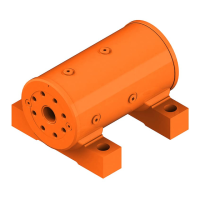23
Parker Hannifin Corporation
Helac/Cylinder Division
Enumclaw, Washington USA
www.helac.com
Helical, Hydraulic Rotary Actuators
L20 Series Service & Repair Manual
Catalog HY34-1120
Testing the Actuator
If the equipment is available, the actuator
should be tested on a hydraulic test bench.
The breakaway pressure — the pressure at
which the shaft begins to rotate — should
be approximately 500 psi (34 bar). Cycle the
actuator at least 25 times at 3000 psi (207 bar)
pressure. After the 25 rotations, increase the
pressure to 4500 psi (315 bar) to check for
leaks and cracks. Perform the test again at the
end of the rotation in the opposite direction.
Testing the Actuator for
Internal Leakage
If the actuator is equipped with a
counterbalance valve, plug the valve ports.
Connect the hydraulic lines to the housing
ports. Bleed all air from the actuator (see
Installation and Bleeding on page 24) Rotate
the shaft to the end of rotation at 3000 psi
(207 bar) and maintain pressure. Remove the
hydraulic line from the non-pressurized side.
Continuous oil ow from the open housing
port indicates internal leakage across the
piston. Replace the line and rotate the shaft
to the end of rotation in the opposite direction.
Repeat the test procedure outlined above
for the other port. If there is an internal leak,
disassemble, inspect and repair.
Avoid personal injury and
machinery damage:
Read the Service and Repair Manual
for proper installation, maintenance
and repair procedures.
Spraying fluids.
Contents under pressure.
Wear approved eye protection.
Use caution when removing
port plugs and fittings.
To avoid contamination
to machined parts:
Make sure work area is clean.
To avoid injury or damage
to product:
Secure product to slotted table or vise.
Testing the Actuator

